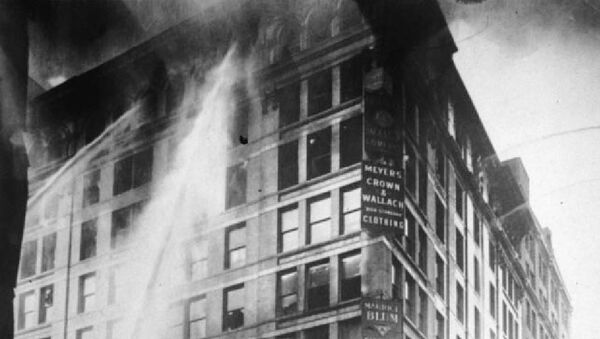At the time, The Triangle Waist Company factory occupied three top of the 10-story Asch Building, now known as The Brown Building, which is currently the is part of the campus of New York University. This factory produced women's blouses, known as "shirtwaists" – hence the name. Most of the 500 workers employed there were young immigrant women, working nine hours on weekdays and seven hours on Saturdays. Usual pay would be around three to five dollars per hour, adjusted for inflation.
At the end of the Saturday shift March 25, 1911, one of the scrap bins caught fire – probably from a match or a cigarette thrown in the trash. The bin had two months of worth of scraps, and, in short, the area had a lot of cloth and wood – in other words, it was highly flammable. Here’s an excerpt from an article in the March 26, 1911 issue of the New York Times:
At 4:40 o'clock, nearly five hours after the employees in the rest of the building had gone home, the fire broke out. The one little fire escape in the interior was resorted to by any of the doomed victims. Some of them escaped by running down the stairs, but in a moment or two this avenue was cut off by flame. The girls rushed to the windows and looked down at Greene Street, 100 feet below them… Then they all began to drop. The crowd yelled "Don't jump!" but it was jump or be burned…
A single exterior fire escape was poorly built and collapsed soon after the fire started. Firefighters, despite arriving relatively early to the scene, were unable to rescue employees as their ladders only went up to the sixths or seventh floors. Overall, the 146 workers– 123 women and 23 men– died in the accident either from the fire directly, from smoke inhalation, or from falling to their deaths. Frances Perkins, author of The Roosevelt I Knew, shared her memories of the event and the aftermath.
There was a stricken conscience of public guilt and we all felt that we had been wrong, that something was wrong with that building which we had accepted or the tragedy never would have happened. Moved by this sense of stricken guilt, we banded ourselves together to find a way by law to prevent this kind of disaster… It was the beginning of a new and important drive to bring the humanities to the life of the brothers and sisters we all had in the working groups of the United States.
A Committee on Public Safety was formed in New York City, headed by Frances Perkins. It introduced new legislation to increase safety of factory workers: for example, one of the introduced bills granted workers shorter hours in a work week. Apart from changing the legal landscape in labor relations, the fire resulted in creation of the American Society of Safety Engineers in October of 1911, the world’s oldest safety society.

